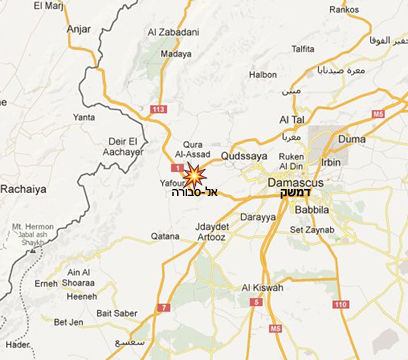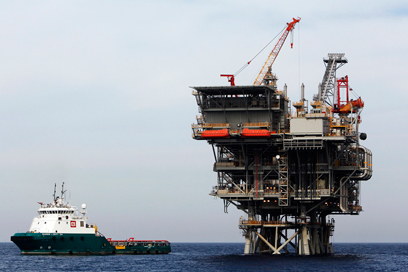Attack into Syria – message to Iran
Analysis: Obama using Israel to show Assad supporters that US is serious when it says 'all options are on the table'
Every Western intelligence agency estimated it would happen soon, and now, according to all indications, it has: Bashar Assad tried to reward Nasrallah and his men - who are fighting and dying for him – by transferring modern, surface-to-surface missiles that would alter the balance of power between the Lebanese Shiite group and Israel. The Jewish state, it was reported, intervened and thwarted, just as the prime minister, defense minister and IDF chief had promised it would. It is safe to assume that the arms convoy was about to leave the storage facility at the Syrian army base toward the Bekaa Valley in Lebanon when it was hit.
The attacked storage facility is apparently located in an isolated base used for training Hezbollah terrorists in the use of "deterrence-breaking" weapons and also serves as a transit station for Nasrallah's organization on the way to Lebanon. Syria has a number of such facilities in the Damascus area and in the coastal region, where most of the Alawite and Shiite-Lebanese population is located. Israeli aircraft flew over Lebanon in the past few days – mainly over south Lebanon, and even carried out simulated attacks. These flyovers were most likely meant to signal to Hezbollah and Syria: We are aware of your intentions and we will not sit idly by – as Defense Minister Moshe Ya'alon warned. It seems, at least according to the American media, that the warning signals were ignored, forcing an attack on the arms convoy.
The attack itself, one can assume, was not carried out from within Lebanese territory, but from a long distance. Perhaps even from over the sea. It is known that Israel has lethal long-range weapons systems – such as the Popeye air-to-surface missile manufactured by Rafael – which allows for very accurate hits from a range of over 100 kilometers (62 miles), maybe even much more. Just so you know, Mr. Khamenei.
Among the strategic and modern weapons systems Israel said it would not allow to be transferred to Lebanon are the Scud D ballistic missiles - based on the original Russian Scud – which Syria developed with Iran's funding. These missiles can carry chemical warheads containing the advanced chemical warfare agent VX to a distance of up to 680 kilometers (423 miles). It is important to stress that according to the relatively credible reports from the Pentagon, the attacked weapons systems did not contain chemical warfare agents – but potentially they could have.

Site of Israeli attack, according to Lebanese reports (Photo: Goggle Maps)
The accurate long-range missiles Assad is trying to transfer to Hezbollah present two problems for Israel: They endanger military facilities and civilians from the north almost all the way to Eilat; and they can be activated far from the border – for instance, from the Hezbollah-controlled area in Lebanon's northern Bekaa Valley – in a manner which would make it difficult for Israeli warplanes to reach them quickly and thwart the launching. The good news is that the "Arrow" system is capable of intercepting - if the number of missiles fired does not exceed a certain amount. Therefore, Hezbollah has an interest in receiving from Syria the largest amount possible of ballistic missiles and long-range rockets of all types –mainly Scud missiles.
According to foreign sources, the Assad regime had already succeeded – even before the civil war broke out – to transfer to Hezbollah in Lebanon a small number of Scud D missiles. Israel was aware but refrained from acting due to Washington's objection. It happened roughly two-and-a-half years ago: The American administration feared an Israeli attack would undermine stability in the Middle East, and the fighter jets, which were already in the air, returned to base. It is safe to assume that since then the Obama administration has changed its position on the issue.

The advanced Scud is not the only weapon capable of breaking the balance of deterrence. Other weapons systems are capable of limiting the IDF's ability to operate deep inside Lebanon should Hezbollah decide to launch a missile and rocket attack. These systems mostly include mobile, "stealth," and accurate anti-aircraft missile batteries and radar facilities which are difficult to locate – particularly the SA-17 surface-to-air missiles, which Russia recently supplied to Syria. The request for the SA-17 was made in the aftermath of the strike on Syria's nuclear reactor in 2007. Now Russia is transferring these missiles to deter NATO from operating as it did in Libya. Assad, for his part, is trying to reward Nasrallah and make things difficult for the Israeli Air Force. This is why an SA-17 battery was attacked last January as it was being transferred to from western Damascus to the Lebanese border.
Hezbollah is also after the anti-ship cruise missiles Russia sold Syria, particularly the "Yakhont" missile. Hezbollah already has in its possession obsolete Iranian-made land-to-sea missiles, such as the one that struck the Israeli missile boat "Hanit" during the Second Lebanon War. But the "Yakhont" is much more advanced and dangerous. It has a 300-kilometer (186 miles) range, it flies at a very high altitude and is equipped with the most advanced systems. The "Yakhont" can serve as a very accurate and devastating missile against targets along Israel's coastline if launched from the Syrian or Lebanese coast.
According to military journals in Russia, the "Yakhont" has the ability to zero in on a target very accurately with a GPS system. The missile has the unique ability of being able to cruise several meters above the water surface, making it difficult to detect and intercept. In short, no gas field is safe from this missile, and, should Hezbollah obtain the "Yakhont," it would make it risky for Navy vessels to sail off Lebanon's coast. Just so you know, Mr. Putin.

'Yakhont' missiles pose a threat. Offshore Israeli gas field (Photo: Reuters)
It is safe to assume that the recent attack targeted surface-to-surface missiles, mostly because Assad and his army do not need these missiles to fight the rebels and can therefore afford to transfer them to Nasrallah, so he could use them against Israel when the opportunity arises (from Nasrallah and Iran's standpoint). If such an opportunity does not arise, Hezbollah will be asked to return the missiles to the Syrian army, in the event that Assad's regime survives.
In addition, the Syrian regime fears that after it used nerve gas against its citizens the West and NATO may launch a military operation. Obama has already said that such an operation would not be conducted on the ground, meaning it would mostly likely be launched from the air, from bases in Turkey, for instance, as well as from the sea – from aircraft carriers and destroyers. One of the plans is to attack missiles that can be used to launch chemical weapons. In order to fend off such an attack the Syrian army would need all its modern surface-to-air batteries and every "Yakhont" launcher it currently has or can obtain from Russia. Therefore, it is unlikely that Assad will transfer vital weapons systems to Hezbollah in Lebanon at this time.
It is interesting that the reports of the recent attack came from Washington and not from sources in the region. During the attack on the SA-17 battery a few months ago, the US remained silent, but gave the impression that it was not against the operation and that it was justified, because Israel is entitled to defend itself. Obama reaffirmed this position during his visit in March. The US made it very clear it does not want "game-changing" advanced weapons to be transferred from Syria to terror elements – particularly Hezbollah. Secretary of Defense Chuck Hagel reiterated this position during his meeting with Ya'alon last month.
Now Washington is making sure to leak to all American media outlets that Israel attacked and what the target was. It is safe to assume that this tactic was employed because Assad's regime tried to "save face" and conceal the blow it had received, and also because the Obama administration, in accordance with its new agreements with Israel, it trying to show Syria and its supporters – Iran, Russia and China – that the US is serious when it says that "all options are on the table." The message: We stand by Israel when it protects itself.










